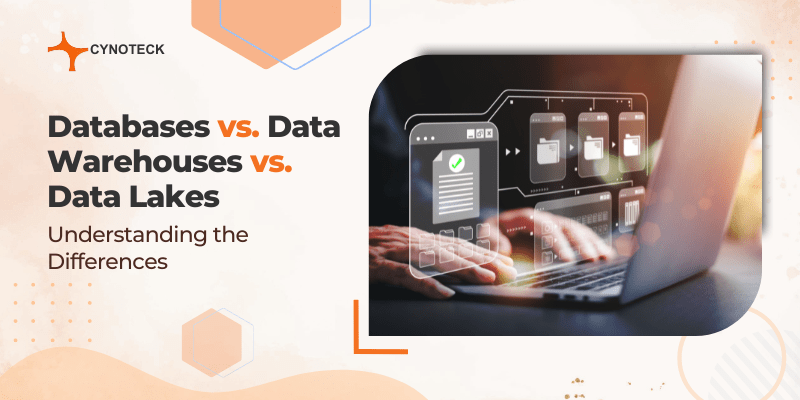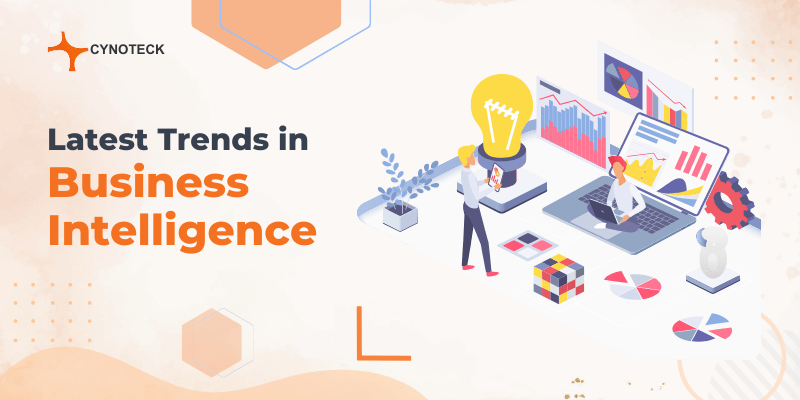In order to provide both operational and analytical benefits, your business should efficiently collect, store, and integrate data from various sources. Data is the starting point for everything, whether it’s discovering new customers to boost sales or cutting expenses. Over time users have multiple alternatives in terms of collating data for various users or merely for storage. Be it databases, data warehouses, or newly created data lakes.
For business intelligence (BI), SQL frameworks, research, and other analytics, data analysts, data scientists, engineers, and managers all need a reliable data storage solution.
Your modern organization needs a data storage solution that is more versatile, scalable, secure, and dependable than any old database. Modern databases, data warehouses, and data lakes are useful in this situation.
What is a Database?
A database is where related data is stored and used to document analytics & usage. A point-of-sale (POS) database is one type of database. All pertinent information on the transactions at a retail business is recorded and stored in the POS database.
Structured, Relational, Relational Database Management Systems (RDBMS), and unstructured data structures, also referred to as “NoSQL,” are some of the several types of databases. The database processes manage, organize, and update new data before storing it in tables.
A platform like MongoDB is an example of a NoSQL database, whereas MS Access is an example of an RDBMS.
Databases are specialized storage spaces for unprocessed transactional data. Online transactional processing, also known as OLTP, is something that databases do since they are so intimately related to transactions.

The use cases for databases for all organizations include:
- Generating financial and other reports
- Analyzing modestly-sized datasets
- Automating operational procedures
- Data entry auditing
Commonly used databases:
To name a few, the following are the most commonly used databases in practice-
1. PostgreSQL
PostgreSQL is an object-relational database; it will immediately make sense to developers who are familiar with object-oriented programming (OOP).
This means that in addition to its relational form, a PostgreSQL table also supports traditional OOP ideas like inheritance and function overloading.
PostgreSQL is a fantastic choice if you need to carry out small-to-medium-scale data processing or conduct complicated queries.
2. MySQL
A complete database management system (DBMS), MySQL. Due to its relational model and ease of understanding, MySQL is maybe the easiest database to learn how to use. For more extensive applications, any of the other choices on this list could be preferable.
3. MongoDB
The first non-relational database on our list is MongoDB, which is renowned for using a document data model rather than a tabular architecture. If your data is unstructured, MongoDB is fantastic and works well with the majority of cloud computing apps.
4. Oracle
The most widely used database as of 2023 is still Oracle. Oracle is a DBMS with a long list of functionalities, just like MySQL.
Although Oracle was initially a relational DBMS, it is today regarded as a multi-model database that supports a variety of non-relational modeling approaches, making it one of the most adaptable and comprehensive databases available.
Also, read: What is Microsoft Fabric? All You Need to Know About
What is a Data Warehouse?
According to GM Insights, The global data warehousing market was worth US$ 28.7 billion in 2022 and is predicted to be worth US$ 51.7 billion by 2028, growing at a CAGR of 10.4% between 2023 and 2028.
There is more to a data warehouse than just being a large database. A data warehouse is not frequently used in software applications. Data warehouses are better suited for extensive data analysis, whereas databases are optimized for speedy read-and-write activities.
Data warehouses store records from various sources, as opposed to databases, which often only have records from one source.
This is due to the fact that a data warehouse’s main objective is to give its customers the ability to conduct analysis on combined data from many (but related) sources.
This enables you to make the most of your reporting and data analytics tools.

Features of Data Warehouse
1. Possessing the capacity to manage enormous data volumes
Data warehouses are ideal locations for historical data like thorough firm spending records since they are built to handle massive amounts of data.
Data warehouses can readily hold petabytes of structured data from numerous sources since they are designed for use cases that cut across entire organizations.
2. ETL assistance
Data is retrieved from a source, transformed into a format compatible with the data warehouse, and then loaded into storage using the extract, transform, load (ETL) process.
ETL functionality is frequently included with data warehouses, enabling users to quickly combine data from many sources and format it by the data warehouse’s schema.
More specifically, 85% of businesses think that big data will completely change how they conduct business.
3. Support for OLAP and BI Tools
Using data warehouses allows you to easily create visualizations of trends and insights because the majority of them are compatible with OLAP software and business intelligence (BI) tools.
Data analysts view data warehouses as essential for creating visualizations and reports because of this.
Commonly used Data Warehouses:
1. Snowflake
Similar to BigQuery, Snowflake uses an architecture that divides the central data storage layer from the data processing layer to decouple storage and computing.
Due to its slight advantage over the competition in terms of performance, scalability, and query optimization, Snowflake is currently the most popular data warehouse.
This does have a cost, though, as Snowflake is frequently more expensive.
2. BigQuery on Google
Another cloud-based data warehouse that excels at managing data analytics is Google BigQuery. BigQuery, unlike Redshift, separates storage from computation so that you can scale each one as necessary.
Additionally, because BigQuery can automatically assign additional compute as necessary, it scales well when dealing with enormous data volumes.
3. Kindle Redshift
A cloud data warehouse called Amazon Redshift has an Exabyte (one billion gigabytes) of storage capacity. Redshift, on the other hand, couples computing and storage, so you can’t grow each one up separately.
Memory must be scaled simultaneously with compute nodes if you simply wish to increase your compute nodes, which can be wasteful.
Also, read: How to Pick the Right Technology Stack for your Data Science Projects?
What is a Data Lake?
Raw and processed (unstructured and structured) data from an organization is kept in a data lake on both a large and small scale.
A data lake collects anything the organization deems valuable for later use, unlike a data warehouse or database. Anything can be used for this—pictures, movies, PDFs, etc.
The data lake will gather information from various unrelated data sources and then process it similarly to a data warehouse.
A data lake can be used for data analytics and report development, just as a data warehouse. In contrast to a data warehouse, a data lake uses far more sophisticated technology.
According to a report by Market Research Future, the data lakes market industry is projected to grow from USD5.1385 Billion in 2023 to USD 21.3687 billion by 2032, exhibiting a compound annual growth rate (CAGR) of 19.50% during the forecast period (2023 – 2032).
Its processing and analysis make use of a variety of programmes and tools, including Java. Data lakes and machine learning are frequently combined. The results of machine learning experiments are frequently also kept in the data lake.
A data lake demands users with competence in programming languages and data science methodologies due to the level of complexity and ability needed to exploit it.
Last but not least, a data lake does not use an ODS for data cleaning, in contrast to a data warehouse.

Features of Data Lake
1. Assistance with unstructured data
Unstructured data can only be stored in data lakes, a special kind of data repository. Anything can be thrown into a data lake, and it won’t raise any issues during writing.
However, this does imply that before you can conduct any useful analysis of the data, you’ll probably need to do some preprocessing on it.
2. Simple scaling
Data lakes may employ less expensive hard drives for storage, making them a considerably more affordable storage choice when compared to databases and data warehouses, which use a lot of expensive RAM and solid-state drives to deliver optimized results.
This indicates that expanding your use of the data lake is simpler and more affordable.
3. Support for Extract, Load, and Transform (ELT)
In its native form, the data in a data lake isn’t ready for processing. Instead, extract, load, and transform (ELT) are supported by data lakes.
ELT extracts data, loads it into the data lake, and then transforms it into the required format, in contrast to ETL for databases and data warehouses.
4. Support for OLAP and BI Tools
Data lakes are completely compatible with OLAP and BI technologies, just like data warehouses are. However, before using these tools, you must conduct ELT on the data.
Also, read: Salesforce Report Types for Best Data Visualization
Similarity between Database, Data Warehouse & Data Lake:
For various use cases, an organization typically needs a data lake, a data warehouse, and a database or databases. All three emphasize gathering data in one location so that various business units may analyze it and draw conclusions from it.
In reality, there are modernized technologies available today that assist in integrating diverse types of data and architectures so that you can connect the dots across your entire organization, regardless of where your data resides.
To facilitate data science analysis and the transition from an exceptionally large passive data lake to implementing real-time data on a gigantic scale, they extend data between data warehouses and data lakes and vice versa.
Also, read: Mastering CRM Data Management: Best Practices for Optimal Business Growth
Database vs Data Warehouse vs. Data Lake: What’s the Difference
A database, a data warehouse, and a data lake differ primarily in that they:
- The most recent data needed to fuel an application is kept in a database.
- Current and historical data from one or more platforms are kept in a data warehouse in a predetermined and consistent schema, making it easier for company analysts and data scientists to analyze the data.
- Business analysts and data scientists can quickly analyze the data thanks to the raw form in which a data lake maintains recent and old data from one or more systems.
- Through an external tool, such as an operational data store (ODS), many databases can connect to a data warehouse. An ODS is not required for the data lake.
- The data warehouse will handle the analytical processing and data cleaning, while an ODS is utilized to connect databases. The data lake will handle all data cleansing and analysis “in-house.”
- A data mart frequently receives more accurate data from the database and data warehouse. A data mart is not necessary for the data lake. Reports, dashboards, and other tools receive enhanced data directly from the data lake.
| Database | Data Warehouse | Data Lake | |
|---|---|---|---|
| Purpose | Organize and manage structured data efficiently | Centralized repository for structured and semi-structured data from multiple sources | Centralized repository for structured, semi-structured, and unstructured data from multiple sources |
| Data Structure | Structured data with predefined schemas | Structured and semi-structured data with predefined schemas | Structured, semi-structured, and unstructured data without predefined schemas |
| Data Integration | Designed for transactional processing | Extract, Transform, Load (ETL) process for integrating data from various sources | Supports both batch and real-time data ingestion |
| Data Processing | Supports transactional and operational tasks | Optimized for analytical processing and complex queries | Supports both batch and real-time data processing |
| Scalability | Vertical scaling (increasing hardware capacity) | Horizontal scaling (adding more servers) | Scalable using distributed computing and cloud storage |
| Data Retrieval | Fast retrieval of specific records using indexes | Complex queries and aggregations for analysis and reporting | Flexible querying using various tools and frameworks |
| Data Governance | Strong data integrity and security controls | Emphasizes data quality, consistency, and accuracy | Limited governance controls, often applied downstream |
| Data Granularity | Fine-grained data representation | Aggregated and summarized data for analysis | Raw and granular data, with potential for aggregation |
| User Base | Operational staff and applications | Business analysts, decision-makers, and data scientists | Data scientists, data engineers, and advanced analytics teams |
| Example Technologies | MySQL, Oracle, PostgreSQL | Amazon Redshift, Google BigQuery | Hadoop, Apache Spark, Amazon S3 |
Choosing the Right Solution:
When deciding how to organize and store all the data in your company, there are a few significant differences to take into account. As was previously established, databases have limits at scale but work best when there is a single source of structured data.
Traditional databases are ineffective for the majority of organizations due to these constraints, which causes managers to pay more attention to data lakes and/or data warehouses.
Structured data, schema-on-write processing, variable speeds, lax security, an open user base, and use cases in reporting, analytics, and automation are just a few characteristics of databases.
Conclusion:
Data lakes, data warehouses, and databases all serve different functions. To keep the current application data, almost every modern application will need a database. Companies might opt to add a data lake, a data warehouse, or both to their databases to analyze both the recent and historical data coming from their applications.
The amount of data that needs to be managed increases as apps, teams, and organizations expand. Engineers, analysts, and business leaders all need to have a thorough understanding of the three different types of data warehouses to manage this huge data effectively.
Hope we were able to present an overview of databases, data warehouses, and data lakes in this article. Now that you know when to utilize each one and how they all work together to maximize the value of your data, maybe you can use it effectively.
Also, read: 5 Ways how data visualization has helped our clients make more money
Frequently Asked Questions:
Databases are designed for transactional processing and storing structured data, while data warehouses focus on aggregating and analyzing data for business intelligence purposes.
Unlike a data warehouse, a data lake stores raw, unprocessed data of various types and allows for schema-on-read, providing flexibility for exploratory analysis and advanced analytics.
Databases are commonly used for managing structured data, ensuring data integrity, and supporting transactional processing in applications like e-commerce, banking, and CRM systems.
Data warehouses excel in business intelligence and decision-making processes, enabling data aggregation, integration, and analysis for industries such as retail, healthcare, and marketing.
Factors to consider include data structure, volume, processing requirements, and analytical needs. Understanding specific use cases and business objectives will help determine the most suitable solution.

Harness the power of Data Science
Unlock hidden opportunities, optimize processes, and make smarter decisions. Contact us today to discover how our Data Science services can propel your organization forward. Don't let your data go untapped. Take action now and revolutionize your business with Data Science.




